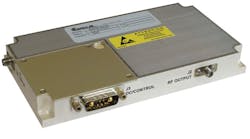Gallium-nitride (GaN) power semiconductor technology is making higher power levels at higher frequencies possible from smaller packages. As proof, two new amplifier modules from Comtech PST build upon GaN technology to deliver a choice of 20 or 50 W output power for CW signals from 6 to 18 GHz from miniature packages—each weighing less than 2 lbs.
The modules operate in Class AB linear mode for consistent output power and high gain across their wide 12-GHz bandwidths (typical DC-to-RF efficiency of 14%). Both models are supplied in compact metal housings measuring just 6.56 × 3.50 × 0.84 in. and weighing no more than 1.5 lbs.
With 20-W or more output power at 3-dB compression, model BME69189-20 provides more than 41-dB gain (and typically 45-dB gain) across the full 6-to-18-GHz operating frequency range. The gain flatness is within ±4 dB. The amplifier module requires only +10-dBm input power to reach overdrive conditions, and exhibits typical input/output VSWR of 2.0:1 or better. It maintains good spectral purity, with typical second-harmonic distortion of -15 dBc, typical third-harmonic distortion of -25 dBc, and spurious content of typically -60 dBc or better.
For those in need of higher power levels, model BME69189-50 (see photo) delivers more than 50 W output power at 3-dB compression from 6 to 18 GHz, with typical gain of 47 dB or better across the full frequency range. As with its lower-power counterpart, it requires only +10-dBm input power for overdrive conditions.
The BME69189-50 exhibits worst-case input/output VSWR of 2.0:1, with load VSWR of 2.0:1 at full power output power. It also achieves very good spectral purity, with typical second-harmonic distortion of -15 dBc, typical third-harmonic distortion of -25 dBc, and spurious content of typically -60 dBc or better.
Both amplifier modules are open/short tested for stability and both incorporate built-in-test (BIT) circuitry with composite fault indication of over-current and over-temperature faults. The amplifier modules, which each run on +28 VDC supply, consume less than 15 W power in standby mode. Both include SMA female input and output connectors and a 7-pin Combo D DC/control connector.
The amplifier modules can be enabled/disabled via a 5-V transistor-transistor-logic (TTL) command, with better than 1 μs response time. Both modules run with noise power output of -105 dBm/Hz. The amplifier modules are tested for shock and vibration per MIL-STD-810F requirements and are designed for operating temperatures from -40 to +55°C.
Comtech PST, 105 Baylis Rd., Melville, NY 11747; (631) 777-8900, FAX: (631) 777-8877

